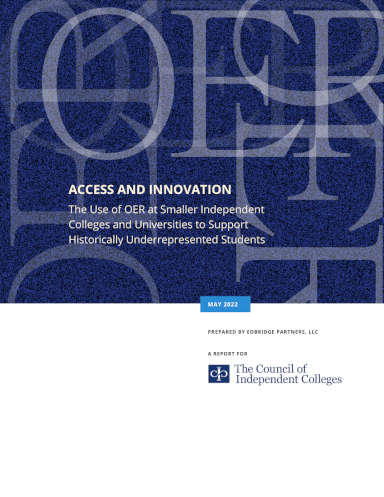After receiving a grant from the William and Flora Hewlett Foundation in 2020, CIC began to study the use of open educational resources (OER) at small to mid-sized independent colleges and universities that are CIC members, with the goal of producing a research report on the findings. This project focused on those institutions that serve historically underrepresented student populations in higher education, such as students who identify as Black or African American or Latinx, students who are the first in their families to pursue a postsecondary education, or students from low-income households.
With over 665 institutional members, CIC represents most colleges and universities in the smaller, independent nonprofit sector. Member institutions are located across the country and include a wide variety, including faith-based colleges, single-sex institutions, Historically Black Colleges and Universities (HBCUs), and Hispanic-Serving Institutions (HSIs). These institutions’ undergraduate profiles range from highly inclusive to highly selective, and they have full-time undergraduate enrollments from under 100 students to over 10,000. This diverse membership provides a valuable cross-section of the entire sector.
The goals of the project were to:
- Compile a list of current OER initiatives at a select group of CIC member institutions, with a focus on projects designed to increase access and eliminate barriers to success for underserved student populations;
- Evaluate the impact of these OER initiatives on students, faculty members, and administrators, focusing on student access and learning, faculty integration of OER in the classroom, and institutional transformation;
- Report on successes and challenges of existent OER projects, using such metrics as the number of courses redesigned, how much money students saved in textbook costs, and the impact on student course evaluations and grades; and
- Use what is learned to determine best practices for the use of OER to support underrepresented students at institutions in the smaller, independent college sector, as a resource for member colleges and universities and a foundation for a new CIC project to promote and develop capacity for OER at member institutions.
To accomplish these goals, CIC developed a curated list of institutions serving historically underserved students from within their membership and sent them an initial survey. Based on the results of that initial survey (see p. 10), CIC sent a longer follow-up survey to a select group of institutions who indicated that they would like to provide more details and information about their OER programs. CIC then employed an external research firm to conduct detailed interviews with six institutions to develop profiles and share their learnings and experiences within this report (see pp. 16–24).
Prepared by edBridge Partners, LLC for The Council of Independent Colleges
May 2022



